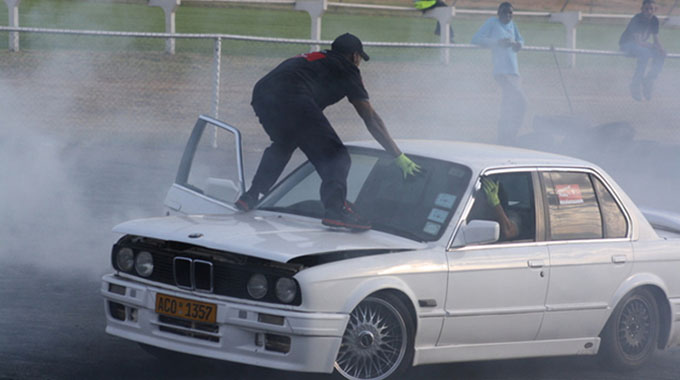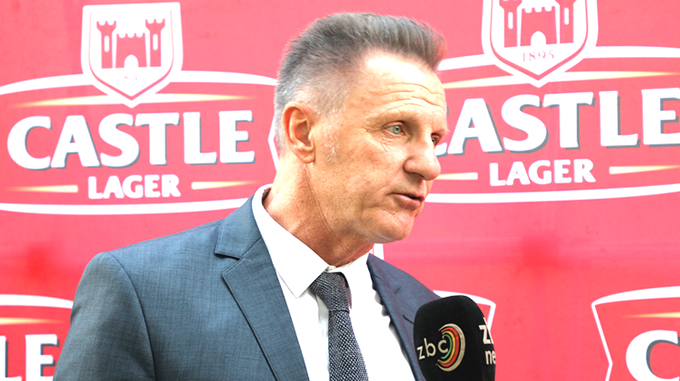Adrenalin of drag racing, burnouts

Talent Gore Lifestyle Writer
THE smell of burnt tyres fills the air, souped-up cars line the Donnybrook raceway lane and groups of over-excited youths mill around waiting and watching eagerly as the two competing cars pull away on a high speed chase. Ever imagined jumping in and out of the car while it spins or open the bonnet while it is still in motion. The screeches, the smoke, the raves and the speed with which the spinners exhibit at “Burn Outs” are part of the fun.
Welcome to Harare’s “fast and furious” drag racing and burnouts scene, an underground sport that has gained popularity over the years in Zimbabwe.
Drag racing is becoming a popular auto culture in Zimbabwe and drivers love to modify their vehicles and have competition at high speeds.
The country has a veritable population of petrol heads and this can be seen by the growth in popularity in terms of both participants and spectators at drag racing and burnout events.
Donnybrook Raceway is one of Zimbabwe’s few permanent racing facilities, built towards the end of the colonial years when the country was still known as Rhodesia, and today, the facility still survives as a hub for local racing.
For those not in the know, drag racing is a type of motorsport that involves two cars or bikes competing to be the first to cross the finish line over a short set distance.
Supercharged cars and bikes provide thrills galore, and the usual variety of music, braais and the free flow of all manner of drinks is sufficient motivation to ensure another bumper crowd turns out.
“Some people misunderstand drag racing, car burnouts and modifying vehicles; they will assume a vehicle that has a loud exhaust, rear exterior or racing wheels is used for street races and the driver is dangerous,” said Khedha (as he is popularly known by his peers)
Khedha, who owns a Subaru WRX, said people modifying their own vehicles is like ladies dressing up with cosmetics, or men wearing a formal suite to attract attention.
“We just get that feeling to race, there are many guys that are trying to build their cars, making it better than the next one,” he said.
“Some people want to build up their own unique style vehicle. Some of my friends ask me about modifying vehicles to make a deep and loud exhaust sound.
“Car modification and car dragging is my favourite hobby and nothing can replace it in my life,” he said.
“Modifying vehicles does not necessarily mean street racing though, there is a big misunderstanding of car dragging and burnouts.”
In Harare, adrenaline junkies meet at Arcadia shopping centre or Long Cheng Plaza to show-case their skills with cars.
Spectators congregate at the roadside and watch racers or dragsters in modified BMW 325iS (gusheshe), Subarus and Altezzas vying for glory and bragging rights, oblivious of the danger posed by the illegal car dragging at shopping centres and streets.
While many people love the adrenaline rush of stomping on the gas pedal of a fast car, the manner in which the locals are doing it comes with a great risk of injury and death especially when they do not do so at designated areas like Donnybrook.
In 2016, a closed circuit television recording of a car that ploughed into a fuel station along Samora Machel went viral. Fortunately in that incident, no one was hurt.
It is crazy to see how people enjoy to see fire blowing out of cars and drivers risking their lives by jumping out of cars moving at high speed.
Another fascinating thing that these adrenaline junkies do is hanging on the doors of spinning cars without fear of falling out.
It is at this moment that I realised that stunts by kombi drivers in the CBD are nothing to make noise about.
Another dragster who spoke on condition of anonymity said in as much as he was an adrenaline junkie, he does not recommend people to speed in the streets.
“I am an adrenaline junkie and I love car dragging but I do not recommend doing so in the streets, I recommend people speed at race tracks because every driver is safer and satisfied,” he said.
“Drag racing is a sport. It is different from normal car racing because we can break our own records of lap time in one day.
“We will not compete with other drivers in the streets. Otherwise, there would be many accidents that would damage our favourite vehicles. Speeding at the race park, not on the highway, can prevent car accidents and injuring other drivers on the road.”
He added: “Also normal drivers should correct their misunderstanding about modifying cars because modification is a kind of hobby to improve the vehicle performance or decoration.
“People should not assume that modified cars are for dangerous street racing.”
Drag racing is an internationally recognised motor sport. In Harare the sport is run by the Sables Dragpro Club, which is a member of the Zimbabwe Motor Sports Federation.
Fifty-year- old Regis Johns who does drag racing said it has kept him going for as long as he remembers.
“I began about 20 years ago and I have enjoyed it since then,” he said.
“I love the speed and the noise.”
Johns’ daughter, Andrea, said although worried, she fully supported her father.
“It is nerve-wrecking that at his age my father is still doing drags, but he is my dad and I support him and I am proud of him,” she said.
Tafadzwa Moyo who has been drag racing for the past two years said his love for speed has seen him return to the tracks.
“When I think of driving fast, I come to the track and that is why I am now drag racing and not speeding on the roads,” he said.
Drag racing has become a lifestyle for adrenaline junkies and when its race day, spectators drive to Donnybrook and this has also turned to be a chillspot for most people in Harare.
Some people just go there to chill with friends while drinking their alcohol and listening to the reeving car engines.









Comments